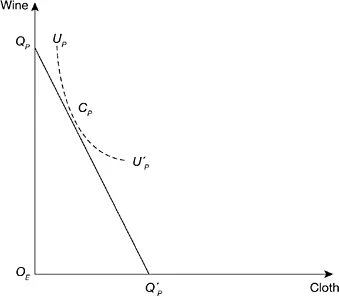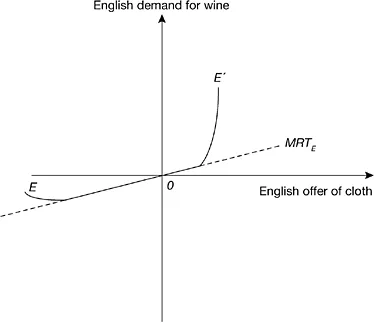
eBook - ePub
International Trade Theory
Murray Kemp
This is a test
Buch teilen
- 240 Seiten
- English
- ePUB (handyfreundlich)
- Über iOS und Android verfügbar
eBook - ePub
International Trade Theory
Murray Kemp
Angaben zum Buch
Buchvorschau
Inhaltsverzeichnis
Quellenangaben
Über dieses Buch
Murray C. Kemp is one of Australia's foremost economists. He has held positions across the world including London School of Economics, U.C. Berkeley, Columbia University, McGill University, MIT, and latterly Macquarie University. Kemp was a Member of Council for the Econometric Society and was a Distinguished Fellow of the Economics
Häufig gestellte Fragen
Wie kann ich mein Abo kündigen?
Gehe einfach zum Kontobereich in den Einstellungen und klicke auf „Abo kündigen“ – ganz einfach. Nachdem du gekündigt hast, bleibt deine Mitgliedschaft für den verbleibenden Abozeitraum, den du bereits bezahlt hast, aktiv. Mehr Informationen hier.
(Wie) Kann ich Bücher herunterladen?
Derzeit stehen all unsere auf Mobilgeräte reagierenden ePub-Bücher zum Download über die App zur Verfügung. Die meisten unserer PDFs stehen ebenfalls zum Download bereit; wir arbeiten daran, auch die übrigen PDFs zum Download anzubieten, bei denen dies aktuell noch nicht möglich ist. Weitere Informationen hier.
Welcher Unterschied besteht bei den Preisen zwischen den Aboplänen?
Mit beiden Aboplänen erhältst du vollen Zugang zur Bibliothek und allen Funktionen von Perlego. Die einzigen Unterschiede bestehen im Preis und dem Abozeitraum: Mit dem Jahresabo sparst du auf 12 Monate gerechnet im Vergleich zum Monatsabo rund 30 %.
Was ist Perlego?
Wir sind ein Online-Abodienst für Lehrbücher, bei dem du für weniger als den Preis eines einzelnen Buches pro Monat Zugang zu einer ganzen Online-Bibliothek erhältst. Mit über 1 Million Büchern zu über 1.000 verschiedenen Themen haben wir bestimmt alles, was du brauchst! Weitere Informationen hier.
Unterstützt Perlego Text-zu-Sprache?
Achte auf das Symbol zum Vorlesen in deinem nächsten Buch, um zu sehen, ob du es dir auch anhören kannst. Bei diesem Tool wird dir Text laut vorgelesen, wobei der Text beim Vorlesen auch grafisch hervorgehoben wird. Du kannst das Vorlesen jederzeit anhalten, beschleunigen und verlangsamen. Weitere Informationen hier.
Ist International Trade Theory als Online-PDF/ePub verfügbar?
Ja, du hast Zugang zu International Trade Theory von Murray Kemp im PDF- und/oder ePub-Format sowie zu anderen beliebten Büchern aus Business & Business generale. Aus unserem Katalog stehen dir über 1 Million Bücher zur Verfügung.
Information
Part I
The classical theory of international trade
1
The Torrens-Ricardo Principle of Comparative Advantage
An extension
1.1 Introduction
Nearly two hundred years on, the Torrens-Ricardo Principle of Comparative Advantage is still widely admired within the profession, and appears prominently in many elementary textbooks and in most treatises on international trade. However, careful inspection of the Principle, either in the mildly disparate formulations of Torrens (1815:264–5) and Ricardo (1817:135) or in any later formulation, reveals that it relies on restrictive assumptions about preferences and technology in each trading country, assumptions that are always implicit, never explicit. Specifically, the Principle rests on the assumption that in autarkic equilibrium each country consumes all commodities, at least incipiently. Our purpose is to make good this claim and to reformulate the Principle in sufficient generality to accommodate alternative assumptions about preferences and technology. In our reformulation the emphasis is on marginal rates of substitution in consumption, not on the traditional ratios of marginal labour costs in production. Thus our restatement concerns not merely the proper display of the Torrens-Ricardo Principle but rather its essential content. It is shown in effect that, in existing formulations, the supply side is assigned a role that it cannot always sustain. That two classical economists overlooked this point can be understood, but the same indulgence cannot be extended to the authors of neo-classical textbooks.1
1.2 The standard formulation
In the usual textbook formulation, two countries, England and Portugal, produce, consume and trade two commodities, cloth and wine; there are no non-tradable commodities. Each commodity is produced by means of a single primary factor, homogeneous labour, under constant returns to scale. Within each country, but not necessarily across countries, all households are identical in all respects: size, age distribution, preferences, quality of labour and access to technical information.2
For England, the household and (by revision of quantity units) the economy-wide production possibility locus is represented in Figure 1.1(a) by the straight segment QEQ′E, the slope of which is (minus) the ratio of the two marginal labour costs of production. In the absence of market distortions, a unique autarkic equilibrium is represented by point CE, where a community indifference curve forms a tangent to the production possibility locus and where, for each commodity, (positive) consumption is equal to production. The equilibrium commodity price ratio is equal to the ratio of marginal labour costs. Similarly, the unique autarkic equilibrium of Portugal is represented in Figure 1.1(b) by point CP.

Figure 1.1a England’s autarkic equilibrium, with incomplete specialization

Figure 1.1b Portugal’s autarkic equilibrium, with incomplete specialization

Figure 1.2a England’s offer curve, with incomplete autarkic specialization

Figure 1.2b Portugal’s offer curve, with incomplete autarkic specialization
Abandoning the assumption of autarky, let us pass in review all conceivable world price ratios. Given any particular price ratio, we can determine the profit-maximizing pair of English outputs, uniquely except when the hypothetical price ratio is equal to the equilibrium autarkic price ratio, and we can determine uniquely the utility-maximizing English consumption pair. Transferring that information to Figure 1.2(a), we obtain the offer curve EOE′ for England, where the straight segm...